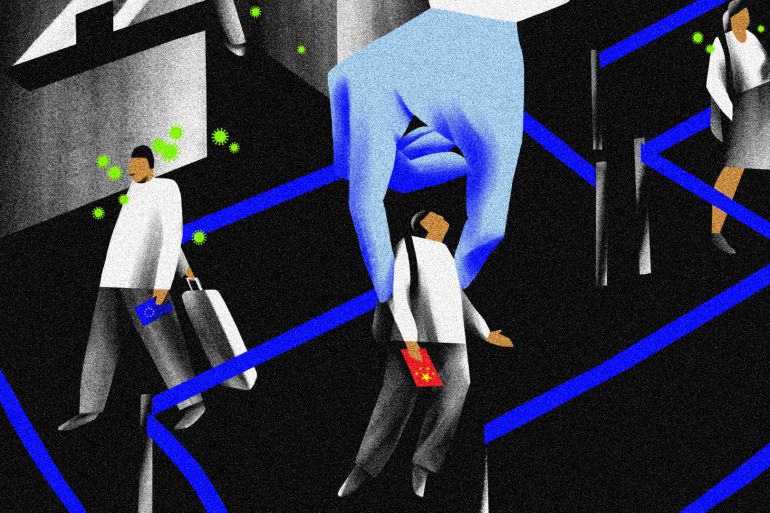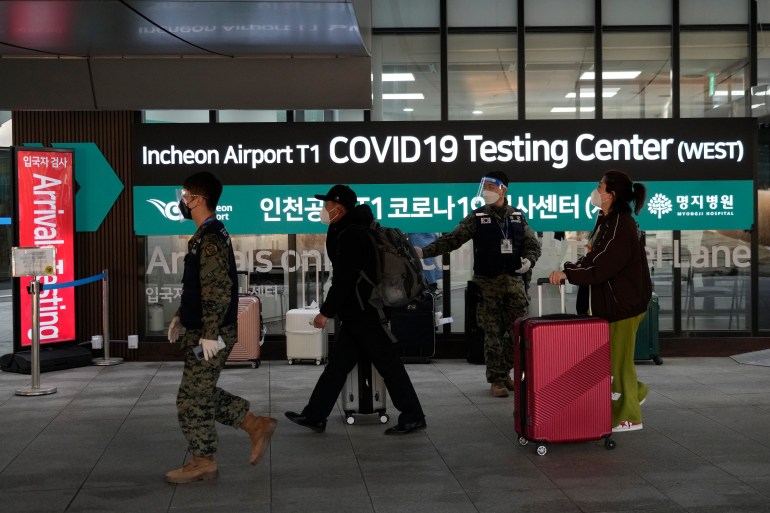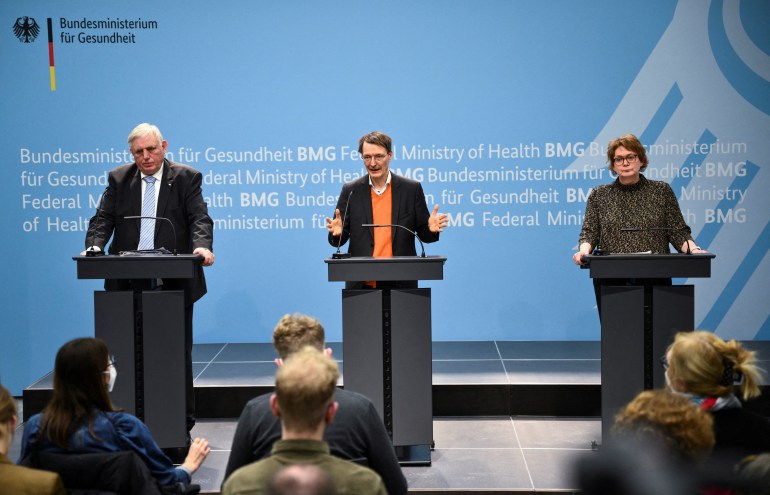Are COVID travel curbs on China making the world safer?
They will not affect global infection numbers or a new variant spread but the curbs might be pushing an opaque China to open up.

With China reversing its strict zero-COVID lockdown policies, infections have been surging across the country. Hospitals are packed, and crematoriums are struggling to cope as bodies come in.
In response, dozens of nations — from the United States and Europe to Asia and Africa — have instituted a range of restrictions targeted at incoming travellers from China. Many, like the US, multiple European nations, India, Japan, South Korea, and Ghana require that travellers from China show negative COVID-19 tests before boarding flights. Some are insisting that these passengers take new tests on landing too, and undergo quarantine if those show positive.
Keep reading
list of 3 itemsChina & COVID | Start Here
Is China’s high-growth era over – forever?
Japan has also limited the number of incoming flights from China. South Korea, meanwhile, ceased issuing tourist visas to Chinese visitors in early January. And Morocco has temporarily banned all entry for visitors from China, regardless of their nationality.
In retaliation, China had stopped issuing short-term visas to South Koreans and Japanese visitors, sparking visions of a return to the chaotic travel landscape of 2020 and 2021, when individual nations imposed patchwork restrictions on each other with little global coordination. On January 29, China said it would resume visas for Japanese citizens.
The US, European Union nations, and many others have justified their measures as aimed at protecting their citizens. Yet in an interview with Britain’s LBC radio, United Kingdom Transport Secretary Mark Harper recently acknowledged another potential rationale for the policies: incentivising Beijing to be more transparent about data related to the COVID surge by raising the consequences of opacity.
So what does the science say? Will the restrictions imposed on Chinese travellers make the world safer?
The short answer: There is little evidence that the curbs will significantly influence either COVID-19 case numbers in other countries or affect the spread of new variants, scientists told Al Jazeera. But the policies might just be working to pressure China to become more transparent.

Will China’s deadly surge spread?
Since it relaxed strict restrictions in December following huge protests, China has struggled against the rapid spread of the virus. Between December 8 and January 12, the country’s hospitals reported nearly 60,000 deaths related to COVID.
A recent projection by the University of Washington’s Institute for Health Metrics and Evaluation estimates that the reversal of zero-COVID rules could contribute to nearly 300,000 deaths by April, and about a million by the end of the year.
Other governments have said they are worried about travellers from China bringing the virus with them. Italy, for instance, introduced its new rules after two planes from China landed with nearly half the passengers on board testing positive for COVID-19. And the Korea Disease Control and Prevention Agency said that the number of virus-carrying visitors from China to South Korea rose exponentially from just 19 in November to 349 in December.
Yet numerous meta-analyses — comparisons of several different types of studies — have shown that such measures are most effective early on in an outbreak when they can slow down the spread of the virus.
Once an infection has spread widely across the world, travel curbs only work alongside domestic policies such as strict mask mandates, social distancing and lockdowns. Few people today have the patience or appetite for such domestic rules any more, Summer Marion, a lecturer and researcher on global studies and health policies at Massachusetts-based Bentley University, told Al Jazeera.
Most countries targeting visitors from China have relaxed mask mandates and other restrictions on their own populations, even while grappling with significant caseloads. The US, for instance, is recording more than 40,000 new cases a day on average.
The optics of appearing responsive to the crisis in China, in the eyes of their own citizens, might be a factor influencing measures that governments have taken, said Michael Osterholm, an epidemiologist and director of the University of Minnesota’s Center for Infectious Disease Research and Policy.
Science likely is not, according to experts.
“Even if every single traveller coming in from China were to be positive,” that would today constitute only a small fraction of the total COVID-19 caseload in the US, said Karen Anne Grépin, associate professor at the University of Hong Kong’s School of Public Health.
South Korea, for instance, reported 31,106 new cases between January 14 and 21 — nearly 100 times the monthly figure of 349 Chinese COVID-positive travellers that spooked it into imposing restrictions.
But the US CDC, in its explanation of its travel restrictions, cited another worry: the potential emergence of “novel variants”.

Can curbs stop a new variant?
So far, there is no evidence that the surge in cases in China is driven by any new variant of the virus.
On January 4, the World Health Organization (WHO) reported that data from China suggests that more than 97 percent of all new cases were from two well-known subvariants of the Omicron coronavirus strain.
The EU’s European Centre for Disease Prevention and Control also recently concluded that “the variants circulating in China are already circulating” in the bloc’s nations and “are not challenging for the immune response” of their citizens.
To be sure, that does not mean that new variants cannot mutate out of existing ones, as infections remain high in China. The US CDC referred to that risk in its announcement of travel restrictions.
“If we believe what public health officials are telling us”, the travel curbs are aimed at stopping “the importation of potentially new variants that may yet evolve in China — but have not yet been established”, Grépin told Al Jazeera.
According to her, that reasoning rings hollow. China is not the only country that has seen spikes in cases recently — infection numbers surged in Japan and South Korea last year — but has been the only one to be slapped with travel measures. There is little evidence to suggest that China has a significantly higher risk of housing new variants.
Grépin pointed out that the new variant spreading like wildfire across the US at the moment — and likely from the US to other countries — is the Omicron subvariant US XBB.1.5, which was first detected in New York City.
In late 2021, when Omicron itself was new, Grépin had argued in an opinion piece for the Washington Post that travel restrictions imposed by the West on South Africa — where it was first found — and other African nations would be ineffective. By the end of December 2021, Omicron had indeed become the dominant variant in the US, despite stricter border control.
New variants today are also less of a reason to worry than they were early in the pandemic, said Peter Chin-Hong, a professor at the University of California San Francisco Health Division of Infectious Diseases.
“You can give me a Dr Doomsday variant,” said Chin-Hong, but “it wouldn’t have the same consequence as early on in the pandemic.” That’s because “the population is in a very different place, with lots of vaccines, boosting, and natural infection waves”, he said to Al Jazeera.
Medicines such as Paxlovid and Remdesivir, widely available today, help too. They are largely effective in helping sidestep the worst of complications from new viral variants because they target enzymes that are crucial for viral replication, irrespective of the variant.
Experiences with past public health crises like Ebola also show that, in addition to dealing with new and localised outbreaks, travel restrictions work best against diseases with severe, rapid onset of symptoms, Chin-Hong said.
COVID-19, with its low infection rate, long latency — symptoms can show several days after a person is infected — and wide global spread does not meet those conditions. A passenger with a negative test could still be carrying the virus.
Yet there is another reason why countries might be imposing tough rules for travellers from China, said experts.

Will China open up on data?
Beijing, on its part, has described the restrictions as “discriminatory”. But other governments and experts have argued that China has only itself to blame.
China was reportedly offered vaccine doses and other aid by the US. But it has insisted that its vaccine and medical supplies were adequate and that “the COVID situation is under control”.
Beijing’s position lacks credibility, Osterholm of the University of Minnesota told Al Jazeera.
China has, in many respects, kept the world in the dark about its COVID-19 data. It has often been accused of passing off COVID deaths as mortality from underlying conditions only exacerbated by the virus. Even its recent estimates of a sharp rise in deaths in December and January are likely far lower than the reality, many experts fear.
“I’m getting more intelligence from China right now, by far, from news reporters on the ground, or from private sector companies [than from the government],” said Osterholm. In either case, the picture is one of an under-vaccinated population poleaxed by an underprepared reversal of zero-COVID policies, with inadequate stockpiles of appropriate antiviral medicines.
So even if the current testing and travel restrictions being placed on China have little chance of affecting outbreaks in other countries, there is still something that governments around the world could gain through these measures. “The only thing you have left is encouraging the Chinese authorities to share more data and do more sequencing of the virus,” says Chin-Hong.
The US CDC hinted as much in its original announcement of the new travel curbs, highlighting “the lack of adequate and transparent epidemiological and viral genomic sequence data being reported” by China. The WHO has also cited China’s lack of data transparency to call travel restrictions “understandable”.
The pressure might be yielding some results.
Since late December, China has dramatically stepped up its contributions of genomic data to the Global Initiative on Sharing Avian Influenza Data (GISAID) sequencing database, allowing scientists from elsewhere to better scrutinise the nature of infections in China. It had turned in only 52 sequences between December 1 and 24 but then submitted 540 over the next six days. And the pattern continued through January, according to GISAID: China submitted 2,641 sequences over the past four weeks.
Many experts, like Marion of Bentley University, caution against attributing the measures focused on travellers from China to a single motivation. Still, transparency seems a key incentive — making these initiatives examples not of data-driven policy, but of policies driving a push to collect data.
Nevertheless, two things are clear. First, said Osterholm, “If you can’t control it in the country from which people are leaving, you’re not going to control it at your border either.” And second, a more transparent China would only bode better for the world’s response to COVID-19.